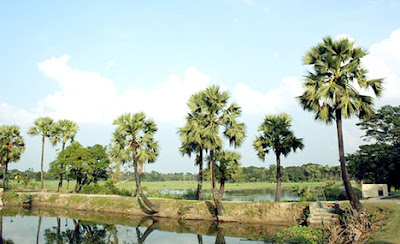 |
| Brojen Das |
Brojen Das was born on 9th December 1927 in Kuchiamora village of Sirajdikhan Upazila, Munshiganj in Bangladesh. His father Harendra Kumar Das was a supplier in army and he had a business of cement trading. Harendra Kumar Das had three sons but no daughter. Brojen Das did his primary education in his native village. He completed his matriculation (final school examination) in 1946 from the AKL Jubilee High School, Farashgonj, Dhaka. Then he passed Intermediate and Bachelor of Arts from Vidyasagor College, Kolkata in West Bengal in India.
As other Bangladeshi boys Brojen Das also started swimming nearby his village river Dholeshory. After completing primary school he moved at Farashgonj,in Dhaka with his parents. The turbulent waters of river Buriganga was his first training ground. From his early life he showed his swimming ability. He championed himself as a master swimmer in an inter-school competition in 1943-45 and inter-college competition in 1948-49. Later in 1952, he became a champion in 100 – meter freestyle in West Bengal in India. The sports lovers in the then Pakistan saw an emerging star in the sports arena when Brojen Das became champion in 100 m, 200 m, 400 m and 1500 m freestyle swimming in 1953 in Bangladesh (the then East Pakistan). He also became the Pakistan’s national champion in 100 m and 200 m freestyle swimming, in 1955. In the same year, he became champion in 100 m, 200 m and 400 m of freestyle swimming in the Pakistan inter university competition. So in most local and national swimming competitions and tournaments Brojen Das proved himself to be an outstanding swimmer.
 |
| King of the Channel-certificate of Brojen Das achievement |
Then Brojen Das arrived in England in June 1958 for the Billy Butlin Channel event as the only participant from South Asian countries. 30 swimmers from 23 countries took part in this competition. The swimming begun at midnight of August 18, 1958 and ended in the afternoon of the next day. 21 of the 30 swimmers dropped out, mostly due to exhaustion, but Bangladeshi Brojen Das continued undaunted to not only to secure the first position in the competition but also became the first Asian ever to complete the swim.
In 1959, he not only succeeded in swimming from the Capri Island to Naples in Italy, but also succeeded in three long-distance international swimming competitions. He swam from England side to France, that took 13 hours and 26 minutes. In the same year he crossed the Channel again from France side to England and took 13 hours 53 minutes to complete the swim. It was also a world record that he was the first long distance swimmer who completed 3 long distance swim in a year.
 |
| Above: Brojen Das with India's former PM Jawaharlal Nehru and down:with Pakistan's former President Ayub Khan |
For his excellent and incredible performance in swimming arena Brojen Das was rewarded many times. The most notable awards that he got were : in 1959 the Pakistan Government honoured him by giving the ‘’Pride of Performance’’. His name was enlisted in the ‘’ International Marathon Swimming Hall of Fame’’ in 1965. Bangladesh Government gave him the National Award in 1976 for his valuable contribution in the field of sports and games. He earned the trophy of ‘’King of Channel’’ from the Channel Swimming Association of the United Kingdom in 1986. He was conferred by Bangladesh government ‘’Swadhinata Padak’’ (post humously) in 1999. He was also awarded by some other Bangladeshi organizations. One of the most significant awards was Dhaka University Blue in 1956.
 |
| Above:Brojen Das with his daughter and son-in-law at his age 65+; down : with his children when they were little |
Due to his achievement he was invited by many countries presidents, prime ministers and even by the queen of UK to meet with them. He came to close contact with many celebraties and legendary people. He got many compliments and recognitions but the best one I think he got when he met legendary boxer Mohammad Ali during the SAF games in 1985 in Dhaka, Bangladesh. The boxing legend said, ‘’You are the king of Channel and I am the king of Ring. But I think your achievement is even greater than mine.’’
In his personal life Brojen Das was married with Madhu Chanda Bose on the 10th February, 1965 in Calcutta, West Bengal. Madhu Chanda Das is a classical music singer. Brojen Das had one daughter Sanghita Pal and one son Soumojit Das.
 |
| Brojen Das with legendary boxer Mohammad Ali during the SAF games in Dhaka in the year 1985 |
Brojen Das became sick when he got first heart attack in 1984. Second time it happened in 1990 and then he did open heart surgery in 1991 in Calcutta, West Bengal, India. After operation he was much better. Few years after in 1997, doctor found that he had cancer in throat. Just after one year he died at the age of 71 on 1st June 1998 in Calcutta, West Bengal, India. His body was cremated at Postagola cremation site in Dhaka, Bangladesh on 3rd June 1998 at night.
Cremated body’s ash of Brojen Das was then thrown in the river Buriganga where he started swimming from his boyhood and earned his name and fame in Channel swimming.
S: brojendas.com; sports-columns.blogspot.com; banglapedia.org; my.opera.com/tuhinra; thedailystar.net/magazine(2009-01-01);






















